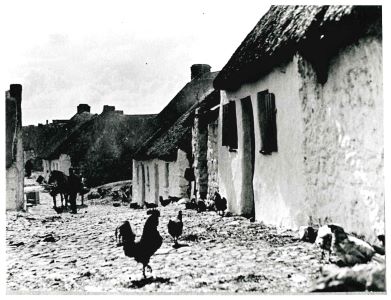CLADDAGH PARADE, c.1910

by Tom Kenny
An article that appeared in the Irish Times on January 7th 1861 was lifted from the Galway Press and started as follows: “Twenty years ago, this fishing village, for which outdoor relief is now deemed necessary, was the greatest source of profit and employment to the people of Galway. It was the wealth producing quarter of the town, and not alone the town of Galway, but many parts of the interior of Ireland felt the benefit of the successful industry of the Claddagh fishermen. The harvest fishing season, which began in August and ended in November, produced a very large accession of wealth to the country. The number of cadgers leaving the town for the interior averaged about 150 daily, and whilst these peripatetic dealers in fish were thus numerously employed, the foremost merchants we had were occupied in filling their stores with herrings, and even the Fishery Board on some occasions were known to barrel large quantities. So abundant frequently was the take that all the cargoes of salt provided by the importers of that article did not suffice, and it had to be brought overland from Limerick and other places”.
Fishing methods had changed in the interim but the Claddagh fishermen refused to keep up with the times and, as a result, their efficiency suffered and the economic situation in the village changed for the worse. Our photograph, which was taken c.1910 by Clement Dowler shows no evidence of those halcyon days having returned. Dogfish Lane was a narrow lane that ran up from the quay, along the wall of the Claddagh Church to a kind of T-junction, and it was there that this picture was taken. It was known as ‘Claddagh Parade’ and the houses we see belonged to, from the right; John Noone; Paddy Curran; Delia Oliver and Stephen Curran. The derelict site to the right of the cart was at one time a house occupied by Naughtons. By the time this photograph was taken, as was quite common in the Claddagh, the stone from that house had been removed and used to build a house elsewhere in the village and in its stead, there was a small laneway that led to Fairhill.
The houses we see in the distance were occupied by Bartley McHugh and Honour Hynes. The gable on the left of picture was part of Cubbard’s house. The stone in the foreground on the right was an ‘anchor stone’ used in a fishing boat. Notice the shutters on some of the windows and the very rough road surface.
The cart we see down the lane was a milk cart owned by Mary Cooke. She was known as “Mary Late” because she often delivered the milk at night. Maybe she knew the photographer was going to be there on this particular day and so turned up early to make the point her nickname was not deserved.
.png)